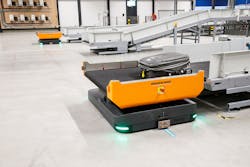Baggage Bots
As a handful of units or as an army, FLEET is designed with the flexibility to work within the confines of an airport’s footprint as an intelligent, autonomous vehicle, offering a flexible and sustainable baggage logistics solution.
“A strong cooperation with airports and users is at the core of the FLEET solution and this helps us to understand and address the challenges facing airports. Only through this close cooperation can the potential of FLEET, to offer a solution that is continually in tune with an airport’s actual demands, be realized,” said Koen Evers, General Manager FLEET.
A FLEET vehicle is composed of six essential parts: the load and unload conveyor, a battery unit, a two-wheel differential motor, the navigation and safety sensor, a status light and wireless connection to the local central control center – where real-time insights into how the FLEET system is performing and its current condition are received.
The battery on the FLEET vehicle lasts for five to six hours on average, with charging being done automatically and managed by the FLEET built-in battery management system.
A FLEET autonomous vehicle works by following management software, which governs the collective behavior of the FLEET vehicles as they interact locally with each other and their environments. Based on real-time data, the route planning of the vehicles is continuously updated and optimized to obtain the highest possible throughput – all while taking up the same amount of space as conventional baggage systems. Features include:
- Flexibility: adding vehicles is easy, resulting in a scalable and flexible solution that’s designed to grow alongside an airport and match its operational needs
- Ease of use: FLEET easily connects to existing systems and setup takes a matter of months, with actual commissioning lasting only a few days, and alterations able to be carried out overnight.
- Sustainability: FLEET is designed to be as energy efficient as possible and is designed to use natural resources in a closed loop, , making the FLEET vehicle recyclable after its lifespan has run out. Maintenance can be planned effectively, as the system continues if one vehicle breaks down – there is no need to make immediate repairs because the rest of the FLEET can still operate unaffected – automatically changing course around the disabled unit.
“Airports can adapt the number of vehicles and routes to their specific capacity needs. This means that having unused assets on the balance sheet is a problem that can be consigned to history. When the needs of an airport or security regulations change, FLEET can adapt to the new situation. In that way, it contributes strongly to improved asset utilization,” said Evers.
Evers said FLEET offers the highest values to airports in three areas:
- Airports with areas that require flexibility in terms of routes; differentiated handling, such as priority bags; areas where change is anticipated or where scalability and expandability are essential
- Areas where a high level of automation and redundancy is crucial and where a traditional system could quickly lead to an overdesigned installation
- Areas where a short-term solution is needed, such as in cases where work on existing baggage systems is taking place, lowering capacity, FLEET provides the temporary capacity that can be moved in and out as needed.
“In the long term, we expect FLEET to handle higher capacities and further enhance the passenger experience. Any vehicle can be given priority, which enables personalized baggage services. Due to its real-time track-and-trace function, travelers will also enjoy a relaxed experience inside the airport without having to worry about the status of their bags. In addition, FLEET can significantly improve the baggage reclaim process, by providing personalized on-demand services, or facilitating remote reclaims,” elaborated Evers.
FLEET is currently in use at Rotterdam The Hague Airport (RTHA), where the airport has been “very satisfied” as the first to trial the technology.
“For us, it was important to have a flexible, efficient, sustainable system that could be scaled up and down as needed,” said Ron Louwerse, CEO Rotterdam The Hague Airport. “We needed a new baggage system because the current one was very outdated, but we needed it to be flexible enough to manage future growth. FLEET gave us the opportunity to trial a system that was independent of the actual number of bags.”
“The trial marks the start of validating the benefits of FLEET for RTHA. The airport was looking to test the values of FLEET in regards to flexibility and efficiency, in combination with improved ergonomics for handlers in a live environment. FLEET’s scalability aligns with RTHA’s desire to have a solution that can match its capacity needs,” added Evers. “The installation was relatively straightforward and even on the first day, the vehicles could drive around their new home. The next step was to determine the ideal route for the vehicles. Performance levels could be optimized simply by changing the routes of the units within the designated layout.”
